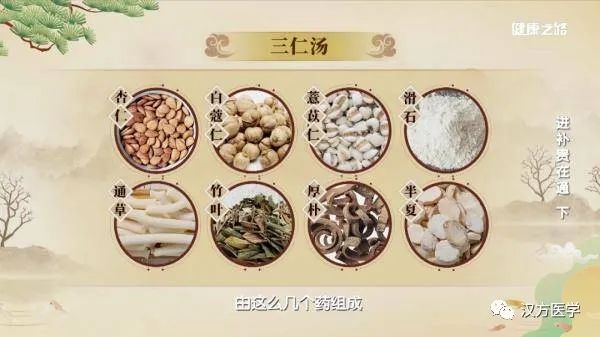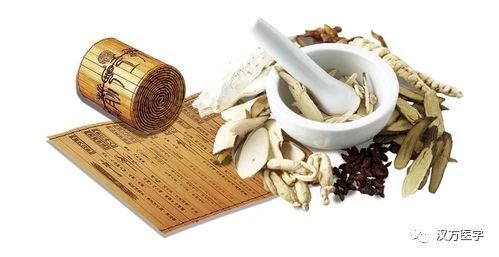
What is damp-heat? It refers to the presence of dampness in the body along with an excess of heat evil.
Dampness is generated in the spleen, and if it accumulates in the body for a long time, it transforms into heat, forming damp-heat. The spleen refines damp-heat, which then travels upward to the lungs. Besides the lungs, where else does damp-heat easily go? I tell you, it goes to the liver. Therefore, individuals with damp-heat in their bodies are particularly prone to bitter mouth, gout, and various unmentionable issues, such as abnormal vaginal discharge and dampness in the scrotum, etc. When we look at the liver meridian pathway, the route perfectly matches.
At this time, one can take Er Miao Wan (Two Marvels Pill). If dampness is greater than heat, then the focus should be on eliminating dampness, with heat-clearing as a secondary measure. Let me share a formula with you: San Ren Tang (Three Nut Soup).
This formula comes from the work of the famous Qing Dynasty physician Wu Jutong in “Wen Bing Tiao Bian”. You may not be familiar with Wu Jutong, but many friends have certainly heard of Yin Qiao San (Yin Qiao Powder) and Sang Ju Yin (Mulberry Leaf and Chrysanthemum Drink). These well-known formulas are all attributed to Wu Jutong. Not only was Wu Jutong skilled in medicine, but he was also very humble. When others praised his achievements, he modestly said that studying medicine is like drilling wood; the predecessors have already drilled nine parts, and I am merely contributing the last part of effort on that foundation.

Returning to San Ren Tang, do not think that it only contains three herbs; it actually consists of eight ingredients. There is a very interesting little rhyme about this formula:“Three people climb a bamboo pole, and plop, they slide down.” This refers to San Ren Tang.
Breaking down this rhyme reveals the composition of San Ren Tang: Xing Ren (Apricot Kernel) 15g, Sheng Yi Yi Ren (Raw Coix Seed) 18g, Bai Dou Kou (White Cardamom) 6g, Tong Cao (Rice Paper Plant) 6g, Zhu Ye (Bamboo Leaf) 6g, Hou Po (Magnolia Bark) 6g, Hua Shi (Talc) 18g, and Fa Ban Xia (Pinellia Tuber) 15g.
The brilliance of San Ren Tang lies in its ability to tackle damp-heat from the upper, middle, and lower parts of the body.
The upper jiao, which includes the heart and lungs, is guarded by Xing Ren. We know that the lungs and large intestine are interrelated, meaning these two meridians are connected. If we imagine the lungs as a teapot, then the large intestine is like the spout. Xing Ren promotes lung qi, slightly opening the lid of the teapot, allowing the water inside to flow quickly through the spout. In simple terms, the role of Xing Ren is to help the water dampness in the upper jiao move downward and be expelled through the intestines.
Bai Dou Kou guards the middle jiao, which can generally be considered the spleen and stomach. Besides being a medicinal herb, Bai Dou Kou is also a spice. Aromatic herbs can restore vitality to the organs. When the spleen and stomach are trapped by dampness, one feels lethargic and drowsy all day long, but upon smelling the fragrance of Bai Dou Kou, one immediately feels alert. Once the spleen and stomach resume their function, dampness will naturally decrease.
What about the dampness in the lower jiao? The best way for this dampness to exit is through urination. Here, Sheng Yi Yi Ren comes into play. When boiled, Sheng Yi Yi Ren has little medicinal taste, but after drinking it, it can promote diuresis and eliminate dampness, helping to dilute the sticky and turbid dampness in the body, which is then directed into the bladder meridian and expelled through urination. Since it clears damp-heat, raw Yi Yi Ren is used, which has a slightly cool nature; after being fried, it becomes much milder.
Some practitioners summarize this process as: promoting the upper, smoothing the middle, and draining the lower.
Now, let’s continue. The role of Tong Cao is just as its name suggests: to open. Where does Tong Cao open? It opens the three jiao. The three jiao is the channel for the movement of water and fluids, as well as the channel for the movement of qi. Tong Cao is responsible for unblocking the three jiao, as ancient medical texts say:“When the three jiao are open, then inside and outside, left and right, up and down are all open.” This way, the movement of water, fire, and qi can flow freely.
Hua Shi, as described by ancient texts, is said to be“able to clear water sources above, and open water pathways below, washing away the heat of the six fu organs.” This means that Hua Shi can expel the damp-heat from the upper, middle, and lower jiao.
Hou Po can move qi, stimulating the movement of qi. On one hand, when qi moves, dampness transforms; on the other hand, when dampness accumulates in the three jiao, it can also affect the movement of qi, so adding a qi-moving herb in a formula for eliminating dampness is very necessary.
Ban Xia here can prevent damp-heat from transforming into phlegm. Ban Xia is an excellent phlegm-transforming herb, and its effectiveness is unquestionable.
Zhu Ye clears heat, primarily by expelling heat through urination.
To be honest, most of the herbs in this formula are quite mild, without being overly bitter or cold, yet the composition is rigorous and has its own strategic arrangement. In this regard, the famous Qing Dynasty physician Xu Dachun commented:“To treat dampness, do not use drying and heating substances; all should be aromatic and mildly draining herbs, to smooth lung qi and harmonize the bladder, this is a good method.”
San Ren Tang achieves this.
San Ren Tang clears heat and eliminates dampness, suitable for conditions where dampness is greater than heat, with dampness being more pronounced and heat showing some signs but not heavily. Individuals of this type will have a red tongue with a thin, white, greasy coating, and their urination will be short and yellow. If the heat is more pronounced, add 3-5g of Jin Yin Hua (Honeysuckle) and Lian Qiao (Forsythia).
Warm reminder:This account aims to promote traditional Chinese medicine culture. The Chinese herbal formulas mentioned in the text are for learning and exchange purposes only.

